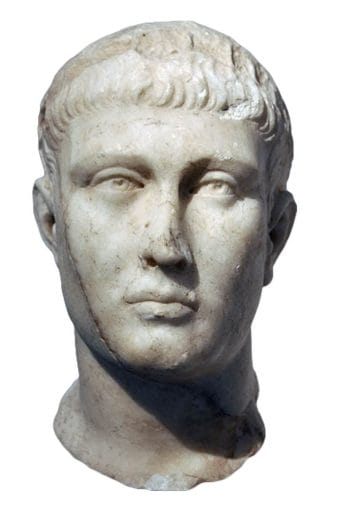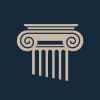Last Updated on December 25, 2021 by Vladimir Vulic
Life: AD 347 – 395

- Name: Flavius Theodosius
- Born in AD 347 at Cauca in Spain.
- Became emperor 19 January in AD 379.
- Wives: (1) Aelia Flavia Flaccilla (two sons; Arcadius; Honorius); (2) Galla (one daughter; Galla Placidia).
- Died in Mediolanum (Milan), January AD 395.
‘Theodosius the Great’ was born in Cauca in the Spanish province of Tarraconensis in AD 347.
His father was Theodosius the elder, who became ‘Master of Horse’ under Valentinian.
Theodosius himself also served in the army, and as a member of his father’s staff when fighting in Britain in AD 368, and thereafter against the Alemanni.
In about AD 373 he became governor of Upper Moesia and oversaw hostilities against the Sarmatians.
Though in AD 375 his father was convicted of treason and put to death, with Theodosius went into exile in Spain.
But after the disastrous battle of Hadrianopolis, which saw the eastern emperor Valen and his army slaughtered by teh Visigoths in AD 378, emperor Gratian recalled Theodosius from exile in order to deal with the disastrous circumstances in the east.
Theodosius achieved remarkable success at dealing with what was a desperate situation along the Danube. As a reward for his troubles, Gratian elevated Theodosius to the rank of Augustus of the east on 19 January AD 379.
In the immediate first years of his reign, Theodosius battled on against the Visigoth forces and the barbarian settlers streaming across the Danube. But the he soon realized the task was an impossible one and in AD 382 he agreed a treaty with them, making allies within the imperial borders.
The treaty allowed the Visigoths to live in Thrace on their own land, with their own laws and their own chiefs. Though, as part of the empire, they would be required to provide soldiers to the empire.
Also part of the treaty was the fact that Theodosius was required to make annual payments to the chieftains of these Visigothic tribes, to pay for troops they continued to command on his behalf.
The barbarian tribes included in this treaty were by no way exclusively Visigothic. Other Germans and even some Huns were part of this agreement.
In a time of a desperate shortage of manpower in the army, the barbarians provided Theodosius with a ready source of fierce and skilled fighters, which not only enlarged his force, but should give him a decisive edge in his struggles with western usurpers to the Roman throne.
Though this enlarged army consumed enormous amounts of money. Theodosius showed even greater determination than Valentinian to increase the amounts he could obtain by taxation.
He was determined that no one should own any property without having to pay tax for it. The laws which were passed to enforce this, were so stringent that they led to widespread oppression.
Theodosius’ relationship with his fellow emperor Gratian in the west was a strained one, largely on religious grounds, but the fact that Theodosius’ father had been executed under Gratian will surely not have made for friendly relations.
But when Magnus Maximus usurped the western throne in AD 383, Theodosius only reluctantly granted him recognition. Largely this recognition was only due to worries about Maximus’ ambitions against Gratian’s young co-Augustus Valentinian II in Italy.
By acknowledging Maximus, Theodosius managed to persuade the usurper to recognize Valentinian II.
Meanwhile, Theodosius promoted his own son Arcadius to co-Augustus of the east in AD 383.
When in AD 387 Maximus invaded Italy in order to dispose of Valentinian II, Theodosius led an army against him. The eastern emperor’s German and Hun troops helped him to defeat Maximus at Siscia and then at Poetovio. Maximus was beheaded in Aquileia (AD 387).
Thereafter Theodosius stayed in Italy until AD 391 effectively acting as sole emperor, despite reinstalling Valentinian II as western Augustus.
Being stern on matters of law and taxation, then on religious grounds, too, Theodosius became seen as a hardliner. Christian heretics were repressed with a series of new laws, at a time even actual religious discussion itself was outlawed.
Though Theodosius himself at times did not fare well himself in religious matters. In AD 390 he was excommunicated by the notorious bishop Ambrose of Mediolanum (Milan) for the massacre of people in Thessalonica who had lynched his ‘Master of Soldiers’.
Only after Theodosius had done penance was he allowed back into the church.
The excommunication was a truly historic event, as it showed the sheer power the church had gained by then. For now the authority of the bishops was such that they could even enforce their will on the emperor. Had the emperor been determined in his religious policy right from the beginning, then what followed was a enforced Christianization of the empire. In AD 391 pagan temples were closed and all of their worships were forbidden by threat of harsh punishment.
As Theodosius returned to Constantinople he left behind his ‘Master of Soldiers’ to assist Valentinian II in his rule of the west. But his faith in Arbogast proved a dire misjudgement of character. For the overbearing Arbogast soon saw to it that Valentinian II was killed and created his own puppet emperor in Flavius Eugenius, who was a minister at the western court.
In AD 393 Theodosius promoted his second son, Honorius, to be the third Augustus in the east.
Thereafter, once again, Theodosius needed to embark on a campaign to remove a usurper in the west (AD 394).
On the river Frigidus he defeated Arbogast in AD 394 and thereafter had Eugenius executed.
Theodosius had in effect involuntarily re-united the two halves of the empire, though it was to be for a brief spell only. For already in January AD 395 Theodosius died at Mediolanum (Milan).

Historian Franco Cavazzi dedicated hundreds of hours of his life to creating this website, roman-empire.net as a trove of educational material on this fascinating period of history. His work has been cited in a number of textbooks on the Roman Empire and mentioned on numerous publications such as the New York Times, PBS, The Guardian, and many more.
